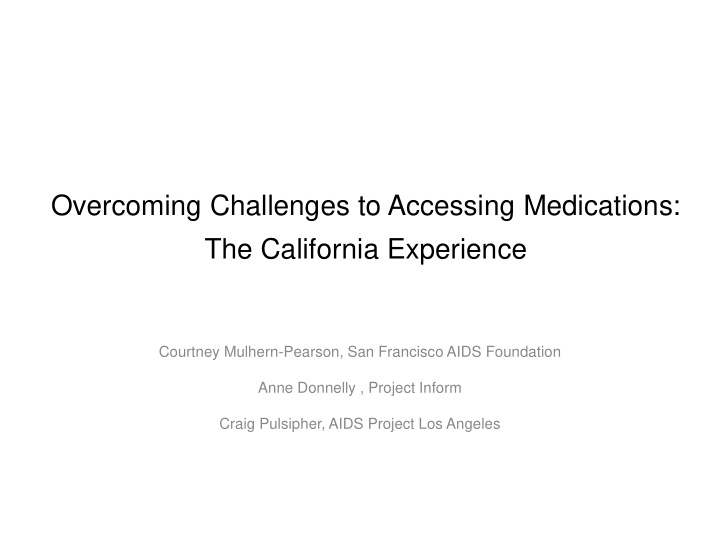



Overcoming Challenges to Accessing Medications: The California Experience Courtney Mulhern-Pearson, San Francisco AIDS Foundation Anne Donnelly , Project Inform Craig Pulsipher, AIDS Project Los Angeles
OVERVIEW
The Access Landscape in California • Covered California: – Still have 4 outlier plans where most or all HIV drugs are on the specialty tier – Drugs on the specialty tier have co-insurance between 10-30% – Most plans have all effective hepatitis C drugs on the specialty tier • Medi- Cal (California’s Medicaid program): – Most access issues are for people living with hepatitis C – Medi-Cal is almost entirely managed care, but HIV medications are carved out and covered through fee for service – Hepatitis C drugs are not carved out which has resulted in access issues • ADAP: – A critical component of the access landscape for people living with HIV – Recent program changes have taught us some lessons that may be helpful for other states
Covered California (CC) • CC convened a ground-breaking specialty drug workgroup to address access and cost issues • Actions thus far for CC plans: – Expanded formulary transparency and access: • Plans are required to have an opt-out retail option for mail order • Plans must provide consumers an estimate of the out-of-pocket cost for specific drugs • Plans must include an exception process written clearly in their formulary • Plans must have a dedicated pharmacy customer service line where advocates and prospective consumers can call for clarification
Covered California (cont’d) • Standardized the formulary tier definitions • If there are three or more treatment options for a condition, at least one drug must be on Tier 1, 2, or 3 – Specifically aimed at reducing cost burden for HIV, hepatitis C, and other diseases – Concern with HIV and hepatitis C is that people need specific drugs • Adopted first of its kind benefit design changes to improve access to high-cost specialty drugs – Caps specialty drug costs at $150-250/month in silver and above plans – Caps specialty drug costs at $500/month in bronze level plans (advocates would like this to be lower)
Medi-Cal • Hepatitis C drugs are covered by managed care plans (not carved out) which has resulted in significant treatment access issues • Medi-Cal recently improved their treatment guidelines, but plans are still not providing sufficient access • Governor Brown pulled together a high cost drug workgroup to look at access issues • Gilead is in the process of changing their patient access program (PAP) so that people who are denied due to restrictive Medicaid criteria will not be able to access drugs through the PAP – This will create huge access issues for a population with no other option
ADAP • California has experienced some savings in our ADAP program due to ACA implementation • Expanded eligibility criteria (from $50k to 500% FPL), changed the family size definition to be consistent with other programs, changed income eligibility calculation from FAGI to MAGI • Should have required state to do an impact analysis of the changes and a waiting period for any person who may lose access due to changes • Should have removed the cost-sharing requirement for anyone with income over 400% FPL (left over from the old program requirements)
LEGISLATIVE FIXES
SB1052 – Formulary Transparency • As of January 1, 2015, plans must post searchable formularies accessible to potential and current enrollees – Must be updated monthly • By January 1, 2017, CDI and DMHC will jointly develop a standard formulary template including: – Cost sharing tiers and utilizations controls (PA and step therapy) – Difference between medical and prescription drug benefits – Process and steps to obtain non-covered drugs • If feasible, require information on cost sharing associated with co- insurance • Working group formed to implement provisions
AB 339 – Health Care Coverage • Plans must cover all medically necessary drugs • Plans must demonstrate that formularies do not discourage enrollment of those with particular health conditions • Plans must cover single tablet regimens (STRs) for treatment of HIV • Limit prescription drug cost sharing to $250 for a 30 day supply – For a product similar to bronze coverage, limit prescription drug cost sharing to $500 for a 30 day supply • Use defined formulary tier groupings • Sunset’s the cost cap and tiering definitions on January 1, 2020
AB 463 – Pharmaceutical Cost Transparency Act • Manufacturers of drugs with a cost of $10,000 or more annually or per course of treatment must file a report on drug production costs, including: o Cost of research and development o Clinical trial and regulatory costs o Material, manufacturing, and administration costs o R & D or other costs paid by other entities o Marketing and advertising o History of cost increases o Financial assistance provided through patient assistance programs • This bill faced significant pharmaceutical opposition and ultimately was not able to pass out of committee so is being held over for the next legislative session
LESSONS LEARNED
Considerations for Other States • For HIV advocates the job has really expanded – not enough to just focus on HIV programs • HIV advocates can’t do it all and collaboration are increasingly important – We have a statewide alliance of HIV advocates, but we also work with other low income health advocates including NHeLP, Health Access, and others • The amount of work is increasing, but the number of people doing the work is decreasing – state based advocates need to think strategically about how to engage and how to collaborate • Increasingly this work requires learning a high level of detail and it’s important to really learn how these programs work in order to gain a seat at the table • Organizations should prioritize this type or work – it’s so critical to have advocates with HIV expertise involved in these decision-making processes
QUESTIONS? CPEARSON@SFAF.ORG ADONNELLY@PROJECTINFORM.ORG CPULSIPHER@APLA.ORG
Recommend
More recommend